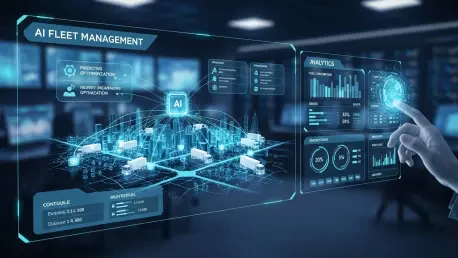With a robust background in logistics and a passion for technology and innovation, Rohit Laila brings a wealth of knowledge to the discussion on fleet management. His insights illuminate how AI-powered solutions can redefine operational structures and enhance safety standards. Let’s explore the transformative journey of Vp Brandon Hire Station as they adopted Samsara’s platform, achieving remarkable results.
What led Vp Brandon Hire Station to seek AI-powered solutions for their fleet operations?
The need for an upgrade was evident as Vp Brandon Hire Station faced the challenge of managing a rapidly scaling operation. They needed more visibility, insight, and an operational structure to manage day-to-day activities effectively. The search for a comprehensive solution to these challenges led them to explore AI-powered platforms.
Can you describe the challenges Vp Brandon Hire Station faced before implementing Samsara’s platform?
Without a structured approach and comprehensive visibility, maintaining consistent safety standards was difficult. The operations were growing quickly across 125 UK locations, and there wasn’t an effective system to consolidate safety initiatives or manage the extensive fleet efficiently.
How did Samsara’s AI-powered platform address the lack of visibility and operational structure?
Samsara’s platform provided real-time insights, which were crucial for enhancing visibility into day-to-day operations. AI dash cams and GPS tracking enabled a better grasp of driver behavior, allowing for immediate interventions and structured reporting, thereby addressing both visibility and operational structure issues.
What specific features of Samsara’s Connected Operations® Platform have been most beneficial for Vp Brandon Hire?
The integration of AI dash cams and GPS tracking was particularly beneficial. These tools provided detailed insights into driver behavior, which facilitated immediate coaching and improved reporting structures. They were instrumental in transforming the company’s safety approach and operational efficiency.
How does real-time fleet data contribute to improved driver behavior?
Real-time data acts as an immediate feedback mechanism. Drivers can be coached on the spot, and interventions are tailored to address specific behaviors. This immediate loop of data and response helps in significantly improving driver behavior swiftly and effectively.
What were some immediate effects observed after deploying the AI dash cams and GPS tracking?
There were notable reductions in accident-related costs and risky driving behaviors. The company observed a substantial decrease in speeding and mobile phone use while driving, which translated into improved safety scores across the fleet.
Can you provide more detail on the significant reduction in accident-related costs since implementing Samsara?
Accident-related costs dropped by 40%, equating to savings of £192,000 annually. This reduction was a direct result of better visibility and improved driver behavior stemming from the insights provided by the AI dash cams and GPS tracking.
What strategies were employed to achieve a 93% reduction in mobile phone use while driving?
The strategy focused on utilizing real-time data to monitor and coach drivers. Educating drivers on the risks and implementing strict monitoring made it easier to address and significantly reduce instances of mobile phone use while driving.
How has the average driver safety score improved over the past eight months?
The average driver safety score improved notably, increasing from 83 to 93 within just eight months. This improvement was driven by targeted coaching, real-time feedback, and the structured use of data to encourage safer driving habits.
How are safety scores utilized in daily operations to monitor performance?
Safety scores are integrated into daily operations as key performance indicators. They are used to monitor driver performance continuously and are a vital part of the decision-making process to raise safety standards across the fleet.
Could you explain the significance of having 92 drivers achieve perfect safety scores?
Achieving perfect safety scores for 92 drivers is a remarkable feat and highlights the effectiveness of the training and feedback system. It demonstrates a commitment to safety and serves as a benchmark for other drivers, reinforcing the safety-first culture within the company.
How does Samsara help identify inefficiencies and priorities within the fleet?
Samsara’s platform sheds light on inefficiencies by providing data-driven insights that highlight areas requiring attention. This prioritized focus allows for the effective allocation of resources and informed decision-making, ensuring continuous improvement in operations.
In what ways have month-end reports evolved with the integration of Samsara’s data?
The reports have become comprehensive, now incorporating health, safety, environment, quality, audits, and road risk data. Samsara’s safety scores are now central to these reports, ensuring that all aspects of safety and efficiency are captured and evaluated regularly.
How is safety perceived as a competitive advantage following the adoption of Samsara?
Safety has become a pivotal differentiator. With enhanced safety measures leading to fewer incidents and thus lower operational costs, Vp Brandon Hire can offer more reliable services. This competitive edge extends beyond mere compliance, positioning them as leaders in fleet safety.
What are the future plans for expanding the partnership with Samsara?
Plans are underway to roll out the Driver App for virtual coaching and implement Connected Forms, which aim at digitizing vehicle inspections. These initiatives will further deepen their integration with Samsara, moving towards a more digitally connected and efficient operation.
How have Vp Brandon Hire Station’s successes with Samsara influenced other companies within the group?
Their success has acted as a catalyst, prompting other companies within the group to consider adopting Samsara. It has set a benchmark for operational excellence and showcases the tangible benefits of employing such technology, influencing decision-makers across the group.
What potential benefits do you foresee with the rollout of the Driver App and Connected Forms?
These tools are expected to streamline processes and enhance safety by providing real-time feedback and structured data collection. The Driver App will facilitate virtual coaching, making it convenient and effective, while Connected Forms will ensure thorough vehicle inspections.
What lessons can other fleet operators learn from Vp Brandon Hire Station’s experience with Samsara?
The key takeaway is the importance of integrating technology for better visibility and structured operations. By leveraging real-time data, other fleet operators can achieve significant improvements in safety, efficiency, and cost management.
Could you comment on Philip van der Wilt’s views about the importance of embedding employee safety into business performance?
Philip van der Wilt’s views highlight the need for a culture shift where safety is ingrained in the business model. Embedding safety into performance metrics not only prioritizes employee well-being but also enhances operational resilience and efficiency.
What is your forecast for fleet management technology in the coming years?
Fleet management technology is poised to become even more sophisticated, with advancements in AI and IoT leading the way. We can expect greater automation, enhanced predictive maintenance, and further integration of data analytics tools to drive efficiency and safety. The future is about making fleet operations smarter and more sustainable through digital transformation.









